Christopher Wilson and Dylan Stableford
Updated Thu, September 14, 2023
NASA announced Thursday that it has created a new position to investigate UFOs following the release of a new report on Unidentified Anomalous Phenomena — or UAP, the preferred government terminology for mysterious objects seen in the sky
Speaking at a press conference in Washington, D.C., NASA Administrator Bill Nelson said the U.S. space agency would be transparent as it moved forward.
“The NASA independent study team did not find any evidence that UAP have an extra terrestrial origin, but we don't know what these UAP are,” Nelson said. “That's why I'm announcing that NASA has appointed a NASA director of UAP research. They are being tasked with developing and overseeing the implementation of NASA's vision for UAP research. We will use NASA's expertise to work with other agencies to analyze UAP.”
Read more on Yahoo News: What are UAPs, and why do UFOs have a new name?, via CBS News
However, the person in charge of UAP research for the agency will remain a secret due to fears that they could be harassed.
The announcement follows the Pentagon’s creation last year of the All-domain Anomaly Resolution Office, or AARO, as the U.S. government continues to take questions over the presence of UAP seriously in public hearings.
Government looks to reduce 'stigma' around UAP reports
NASA Administrator Bill Nelson speaks during a briefing in Washington, D.C., Thursday. (Celal Gunes/Anadolu Agency via Getty Images)
Nelson said it was important to destigmatize the reporting of UAP in order to increase the amount of data available to investigators. In its report, the 16-person independent study group found that the “negative perception surrounding the reporting of UAP poses an obstacle to collecting data on these phenomena.”
“NASA’s very involvement in UAP will play a vital role in reducing stigma associated with UAP reporting, which almost certainly leads to data attrition at present,” the report continued. “NASA’s long-standing public trust, which is essential for communicating findings about these phenomena to citizens, is crucial for destigmatizing UAP reporting.”
In previous congressional testimony, Navy pilots had said their colleagues who work for commercial airlines worried their careers would be negatively affected by mentioning UAP sightings and noted the lack of a system for reporting through the Federal Aviation Administration.
Read more on Yahoo News: What we learned from the UAP study, via BBC
NASA Associate Administrator Nicola Fox said Thursday that the organization will “advance citizen reporting by working with the public and commercial pilots to collect a broader set of data.”
While the officials promoted their desire for transparency in the process, they refused to publicly name the new director of UAP research. When asked about the decision to not release the director’s name, the administrators said they wanted to protect them from harassment and threats as they did their work, citing the experience of some of the study group members.
“We at NASA take the sanctity of the scientific process and the security and safety of our team extremely seriously,” said Dr. Dan Evans, NASA's assistant deputy associate administrator for research. “That’s in part why we are not splashing the name of our new director out there. Because science needs to be free.”
NASA’s response to alleged alien corpses found in Mexico
Remains of one of the "non-human" beings presented to Mexican lawmakers by self-proclaimed UFO expert Jaime Maussan is seen in Mexico City on Wednesday.
NASA officials also were asked about a hearing in Mexico City earlier this week during which a self-proclaimed UFO expert appeared before Mexican lawmakers to present the alleged remains of two alien corpses.
"This is something that I have only seen on Twitter," said Dr. David Spergel, who chaired NASA’s study on UFOs. "If I was the Mexican government, my recommendation would be if you have something strange, make samples available to the world scientific community, and we'll see what's there."
"One of the main goals of what we're trying to do here today is to move conjecture and conspiracy towards science and sanity," he added. "And you do that with data."
Read more on Yahoo News: Mexican congress shown supposed bodies, X-rays, of 'non-human alien corpses' at UFO hearing, via USA Today
During his introductory remarks, Nelson noted that he personally believed in intelligent life elsewhere.
“If you ask me: Do I believe there's life in a universe that is so vast that it's hard for me to comprehend how big it is? My personal answer is yes,” Nelson said.
Efforts in Congress and at the Pentagon
U.S. Deputy Director of Naval Intelligence Scott Bray points to a video of an Unidentified Aerial Phenomena, or UAP, as he testifies before the House Intelligence Committee on Capitol Hill in Washington, D.C., May 17, 2022.
Over the last two years, Congress has held multiple hearings with members of the military about UAP. Last year, Democrats in the House held the first public hearing on the topic in more than 50 years. At a Senate Armed Services hearing in April, the head of the Pentagon office studying UAPs said it had “found no credible evidence thus far of extraterrestrial activity, off-world technology or objects that defy the known laws of physics.”
In July, a former Pentagon official testified to the House Oversight Committee that he was “absolutely” certain the government had possession of nonhuman craft, although that was based on a series of witness interviews and he had not seen the material himself. The Pentagon has strenuously denied the claims.
At a White House briefing the same month, John Kirby, a retired Navy admiral and the current Pentagon spokesperson, said that UAP “have already had an impact on our training ranges.”
“Now, we’re not saying what they are or what they’re not,” Kirby said. “We’re saying that there’s something our pilots are seeing. We’re saying it has had an effect on some of our training operations. And so we want to get to the bottom of it. We want to understand it better.”
Updated Thu, September 14, 2023
By Joey Roulette
WASHINGTON (Reuters) -NASA on Thursday said it has named a new director of research into what the government calls "unidentified anomalous phenomenon," or UAP, while the U.S. space agency's chief said an expert panel that urged deeper fact-finding on the matter found no evidence of an extraterrestrial origin for these objects.
Administrator Bill Nelson made the announcement about the new research chief - without disclosing the person's identity - after the independent panel of experts recommended in a new report that NASA increase its efforts to gather information on UAP and play a larger role in helping the Pentagon detect them.
UAP are better known to the public as unidentified flying objects, or UFOs.
Nelson during a news conference also gave his personal opinion that life exists beyond Earth.
"There's a global fascination with UAP. On my travels, one of the first questions I often get is about these sightings. And much of that fascination is due to the unknown nature of it," Nelson said.
"If you ask me do I believe there's life in a universe that's so vast that it's hard for me to comprehend how big it is, my personal answer is, 'Yes,'" Nelson added.
But Nelson said the chances that otherworldly beings have visited Earth are low.
The NASA panel, comprising experts in fields ranging from physics to astrobiology, was formed last year and held its first public meeting in June.
"The NASA independent study team did not find any evidence that UAP have an extraterrestrial origin, but we don't know what these UAP are," Nelson said, adding that a goal of the agency is to "shift the conversation about UAP from sensationalism to science."
The U.S. government in the past few years has made several disclosures of information it has gathered regarding a subject that once was met by virtual official silence. It issued a watershed report in 2021 compiled by the Office of the Director of National Intelligence in conjunction with a Navy-led task force encompassing numerous observations - mostly from military personnel - of UAP.
"The mission of NASA is to find out the unknown," Nelson said.
"Whatever we find, we're going to tell you," Nelson added, promising transparency on any discoveries.
The new UAP research director will handle "centralized communications, resources and data analytical capabilities to establish a robust database for the evaluation of future UAP," NASA said.
Nelson told Reuters he does not know the name of the new director. Dan Evans, a senior research official in NASA's science unit and a member of the study team, said harassment that other panel members had received from the public during their work was "in part" why the new director's identity was being kept secret.
'A VITAL ROLE'
"NASA has a variety of existing and planned Earth- and space-observing assets, together with an extensive archive of historic and current data sets, which should be directly leveraged to understand UAP," the panel's report said.
"Although NASA's fleet of Earth-observing satellites typically lack the spatial resolution to detect relatively small objects such as UAP, their state-of-the-art sensors can be directly utilized to probe the state of the local earth, oceanic and atmospheric conditions that are spatially and temporally coincident with UAPs initially detected via other methods," the report said.
NASA's science chief Nicky Fox declined to say how much funding the agency would like to allocate toward the continued UAP-tracking effort.
The 2021 government report included some UAP cases that previously came to light in the Pentagon's release of video from naval aviators showing enigmatic aircraft off the U.S. East and West Coasts exhibiting speed and maneuverability exceeding known aviation technologies and lacking any visible means of propulsion or flight-control surfaces.
That report said defense and intelligence analysts lacked sufficient data to determine the nature of some of the objects, while some could possibly be explained as atmospheric phenomena, advanced aircraft from another country or innocuous objects such as weather balloons.
The new report called UAP "one of our planet's greatest mysteries."
"Observations of objects in our skies that cannot be identified as balloons, aircraft or natural known phenomena have been spotted worldwide, yet there are limited high-quality observations. The nature of science is to explore the unknown, and data is the language scientists use to discover our universe's secrets," the report stated.
"Despite numerous accounts and visuals, the absence of consistent, detailed and curated observations means we do not presently have the body of data needed to make definitive, scientific conclusions about UAP," it added.
(Reporting by Joey Roulette; Editing by Will Dunham)
Nina Golgowski
Thu, September 14, 2023
A yearlong study commissioned by NASA on unidentified anomalous phenomena (UAP) ― also known as UFOs ― failed to find evidence that they are extraterrestrial in origin.
“We don’t know what these UAP are but we’re going to try to find out,” NASA Administrator Bill Nelson said at a press briefing Thursday.
The report, commissioned in June of last year and conducted by a panel of 16 independent experts, concluded that NASA is capable of using existing technology to better understand and investigate UAP and that it can reduce the stigma long associated with reporting these sightings.

NASA Administrator Bill Nelson speaks during a media briefing Thursday on UAP at NASA headquarters in Washington, D.C.
NASA Administrator Bill Nelson speaks during a media briefing Thursday on UAP at NASA headquarters in Washington, D.C.
“Most UAP sightings result in very limited data,” Nelson said. The report noted that these sightings are often ultimately identified as balloons, aircraft or known natural phenomena.
“We want … private pilots, commercial pilots, military pilots, to feel that if they see something they need to report it,” said Nicola Fox, associate NASA administrator.
To help spearhead its efforts, NASA officials announced the appointment of its first director of UAP research, though the agency declined to share his name.
Daniel Evans, a senior official in NASA’s science mission directorate, cited harassment that some of the panel members experienced while conducting the study for keeping the director’s name a secret.
“Some of them actually rose to actual threats,” he said. “Science needs to be free. Science needs to undergo a real, rational process, and you need the freedom of thought to do that.”
Nelson said officials are keeping an open mind about what UAP are, adding that he personally believes there’s life beyond our solar system. He expressed doubt that these UAP are extraterrestrial, however, due to the distance they would have to travel to reach our planet.
“It would have to be a very advanced civilization,” said Nelson, who traveled to space while a Florida congressman in 1986. “The distances, you know: light years, hundreds of light years, billions of light years. But whatever we find we’re going to tell you.”
Andrew Griffin
Thu, September 14, 2023
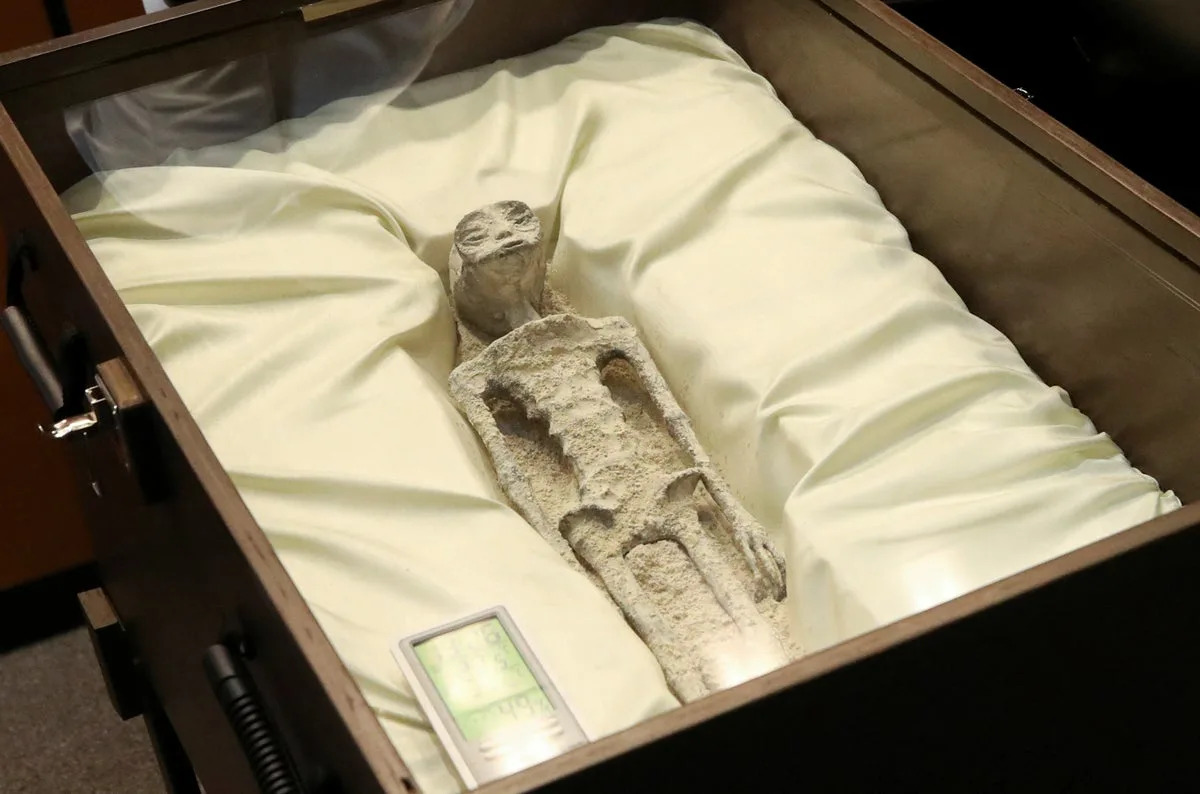
(Reuters)
Supposed aliens found in Mexico “make no sense”, a scientist has said, and are lacking in proof.
This week, strange looking, humanoid bodies were presented in Mexico’s Congress. They were claimed to be extraterrestrial, and immediately kicked off internet excitement that the first ever alien remains had been found.
But scientists have been quick to point out that there is no good evidence that the remains are real – and that they might not be bodies at all. Even others who had taken part in the same hearings criticised the reveal as an “unsubstantiated stunt”.
At the Congress hearings, Mexican journalist José Jaime Maussan presented two boxes with supposed mummies found in Peru, which he and others consider “non-human beings that are not part of our terrestrial evolution.”
The shrivelled bodies with shrunken, warped heads left those in the chamber aghast and quickly kicked up a social media fervour.
“It’s the queen of all evidence,” Maussan claimed. “That is, if the DNA is showing us that they are non-human beings and that there is nothing that looks like this in the world, we should take it as such.”But he warned that he didn’t want to refer to them as “extraterrestrials” just yet.
The apparently desiccated bodies date back to 2017 and were found deep underground in the sandy Peruvian coastal desert of Nazca. The area is known for gigantic enigmatic figures scraped into the earth and seen only from a birds-eye-view. Most attribute the Nazca Lines to ancient indigenous communities, but the formations have captured the imaginations of many.
In 2017, Maussan made similar claims in Peru, and a report by the country’s prosecutor’s office found that the bodies were actually “recently manufactured dolls, which have been covered with a mixture of paper and synthetic glue to simulate the presence of skin.”
The report added that the figures were almost certainly human-made and that “they are not the remains of ancestral aliens that they have tried to present”. The bodies were not publicly unveiled at the time, so it is unclear if they are the same as those presented to Mexico’s congress.
On Wednesday, Julieta Fierro, researcher at the Institute of Astronomy at the National Autonomous University of Mexico, was among those to express skepticism, saying that many details about the figures “made no sense.”
Fierro added that the researchers’ claims that her university endorsed their supposed discovery were false, and noted that scientists would need more advanced technology than the X-rays they claimed to use to determine if the allegedly calcified bodies were “non-human”.“
“Maussan has done many things. He says he has talked to the Virgin of Guadalupe,” she said. “He told me extraterrestrials do not talk to me like they talk to him because I don’t believe in them.”
The scientist added that it seemed strange that they extracted what would surely be a “treasure of the nation” from Peru without inviting the Peruvian ambassador.
Congressman Sergio Gutiérrez Luna of the ruling Morena party, made it clear that Congress has not taken a position on the theses put forward during the more than three-hour session.Believing or not was up to each member of the legislative body, but those who testified had to swear an oath to tell the truth.
Gutiérrez Luna stressed the importance of listening to “all voices, all opinions” and said it was positive that there was a transparent dialogue on the issue of extraterrestrials.
After the hearings were over, Ryan Graves – a former US fighter pilot who has described unexplained encounters with flying objects – said that he had been disappointed by who he had shared a stage with. He said that he had accepted the invitation “hoping to keep up the momentum of government interest in pilot experiences with UAP”.
“Unfortunately, yesterday’s demonstration was a huge step backwards for this issue,” he wrote on Twitter. “I will continue to raise awareness of UAP as an urgent matter of aerospace safety, national security, and science, but I am deeply disappointed by this unsubstantiated stunt.”
Popular scientist Brian Cox also said that the supposed corpses were “way too humanoid”.
“It’s very unlikely that an intelligent species that evolved on another planet would look like us. Secondly - send a sample off to 23andme - let alone the University down the road - and they’ll tell you within 10 minutes,” he wrote on Twitter.
Additional reporting by Associated Press
Owen Jarus
Thu, September 14, 2023
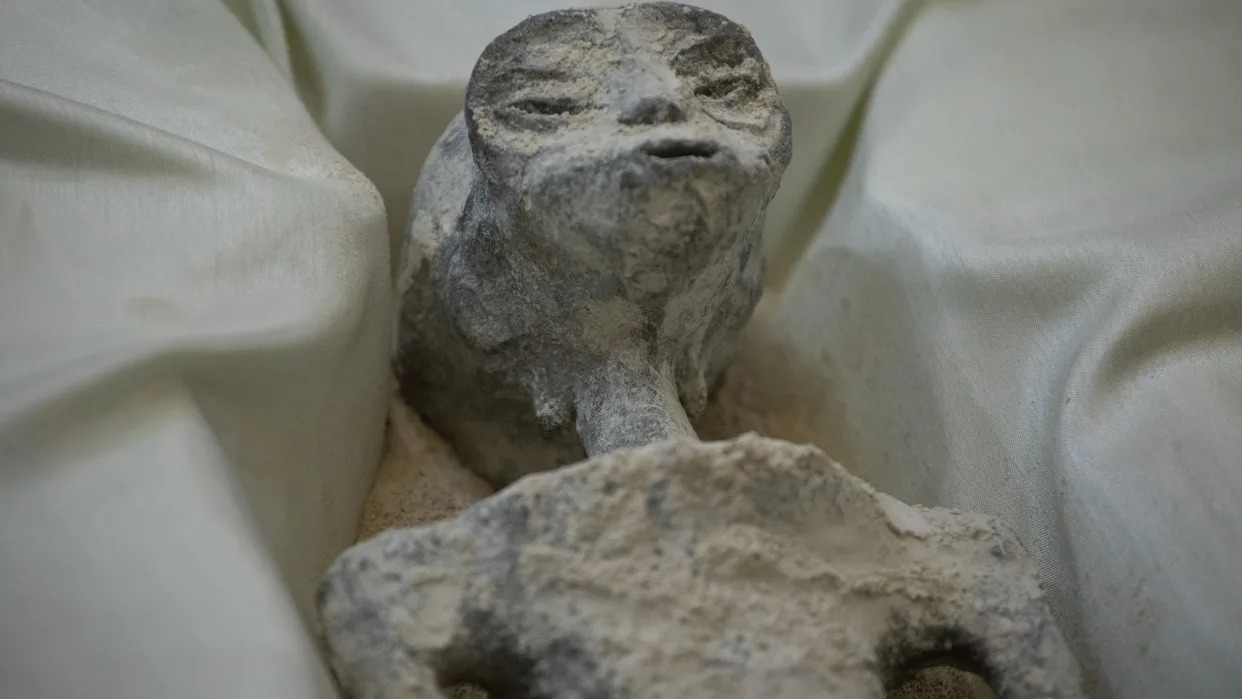
We see a grayish head and torso of an "alien" in a pillow-like box
In a now-viral story, "alien" bodies were unveiled before Mexico's congress Tuesday (Sept. 12). But is there any real science behind this bizarre event?
Not by a long shot, according to scholars, who denounced the claim and affirmed that the bodies are not alien.
Mexico's congress was holding a hearing on unidentified aerial phenomena (UAP), a term that is now used to describe UFOs. UAPs have also been the subject of congressional hearings in the United States over the past two years.
During the presentation, a team that included Mexican journalist Jaime Maussan and military medical doctor José de Jesús Zalce Benítez presented two bodies — which appear to be no more than 3.3 feet (1 meter) tall and appear skinny with grayish skin and large heads — in coffin-like boxes before Mexico's congress. They claimed that DNA tests reveal that the remains of these three-fingered beings are not human and that their abdomens hold eggs that may be used in reproduction. The duo also said the bodies came from Peru and that radiocarbon dating shows they date back 1,000 years, National Public Radio reported.
The same bodies made headlines in 2017 and 2018, Maussan told Live Science in an email. At the time, scholars denounced those bodies as consisting of manipulated human body parts. Maussan told Live Science that since that time, more tests have shown that the bodies are not human. He also stressed that he is not saying these bodies are necessarily alien — just that they are not human.
Related: Why are we seeing so many UFOs over America all of a sudden?
"We never said they are extraterrestrial," Maussan said, adding that they had found evidence for implants made of the elements osmium and cadmium inside the bodies, "a technology unknown 1,000 years ago." Live Science was unable to reach de Jesús Zalce Benítez at press time.
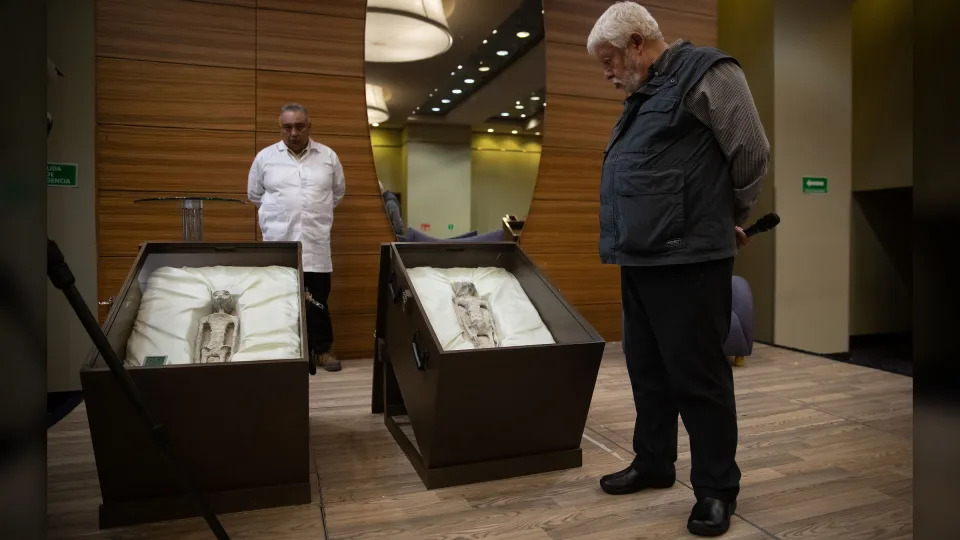
We see two
Scientists blast claims
"Let me tell you that all this is complete nonsense," Rafael Bojalil-Parra, research reinforcement director at Metropolitan Autonomous University (UAD) in Mexico City, told Live Science in an email. "That our Congress gives a forum to this self-proclaimed UFOlogist is a reflection of the anti-scientific mood that prevails in our country today."
There were reports in some media outlets that tests on the bodies were performed at UAD. But Bojalil-Parra said no DNA tests were performed at the university, and while a carbon-14 test was conducted in 2017, a commercial agreement prevents the university from disclosing the results.
Tellingly, if the bodies were aliens, then carbon-14 dating would be useless. "Radiocarbon dating is based on Carbon 14 atoms which are created when the sun's radiation strikes the Earth's upper atmosphere," David Anderson, an assistant professor of anthropology who has written about pseudoarchaeology extensively at Radford University in Virginia, told Live Science in an email. "To radiocarbon date extraterrestrial beings, we would have to know what the rate of production of 14-C was on their home planet, not ours."
Other scientists also denounced the claims. "It is sad to see the well debunked claims of Jaime Maussan returning to the internet," Andrew Nelson, chair of anthropology at Western University in Ontario, told Live Science in an email. The bodies "have been debunked on the basis of anatomy," with studies showing that some of the bodies "are human mummies that had been deliberately manipulated to appear alien," Nelson said. They show, for example, the feet of the "aliens" could have been created by mutilating the foot of a human mummy.
"The feet would have suffered mutilations of digits I and V, in addition to the cutting of the skin and soft tissue of the foot behind the toes, producing a foot with extremely long toes," Rodolfo Salas-Gismondi, a vertebrate paleontologist at the Cayetano Heredia University and the Museum of Natural History in Lima, wrote in a 2017 analysis.
Nelson said that "while Maussan claims to have CT, C-14 and DNA evidence, he has not presented that evidence for peer review by the scientific community." Nelson added that if these remains are in fact 1,000 years old and from Peru, it raises questions as to whether they were looted and how they left the country.
Another scientist said that if the remains are human, those involved with the claims should face legal implications. They "should be arrested and tried for whatever laws might apply for exploiting or desecrating human remains," Ken Feder, an archaeology professor at Central Connecticut State University, told Live Science in an email.
The hearing in Mexico took place partly because there have been high profile hearings on UAPs in the United States congress noted Jeb Card, an assistant teaching professor of anthropology at Miami University in Ohio. While "no one has yet wheeled out alien bodies in the US Capitol," Card told Live Science in an email, there has been testimony before the U.S. Congress made by former military officials that the American government has biological remains of aliens.
The growing popularity of conspiracy theories helps to explain why stuff like this is occurring, Card said. "The simple reality is that it is now profitable — figuratively and literally — to push narratives that 'elites' are inflicting their will on the broader people through devious, conspiratorial, and at times supernatural means."
Live Science contacted Peru's Ministry of Culture, which did not return requests for comment by the time of publication.
Researcher shows purported "non-human" beings at UFO hearing
Updated Fri, September 15, 2023
A journalist and researcher on unidentified anomalous phenomena (UAP), or UFOs as they're better known, presented the remains of purported "non-human" beings to lawmakers in Mexico on Tuesday during the country's first public congressional hearing on the topic.
Jamie Maussan brought two boxes containing what he said were the small, stuffed bodies of extraterrestrials recovered in Peru in 2017. He said carbon-14 dating carried out by the National Autonomous University of Mexico had determined the remains were 700 and 1,800 years old. Each of the figures has only three fingers on each hand and elongated heads, resembling, at least superficially, the Hollywood-born character ET.
"This is the first time it (extraterrestrial life) is presented in such a form and I think there is a clear demonstration that we are dealing with non-human specimens that are not related to any other species in our world," Maussan told the lawmakers, urging them to consider the topic, which he said should not be viewed as "a political topic — it's a topic for humanity."
He said DNA evidence could prove the specimens were not of this planet, but it wasn't clear if any such tests had been carried out.
At least one previous claim by Maussan about purported "non-human" remains discovered in Peru has been debunked, though the specimens he presented Tuesday in Mexico City appeared different to the one he previously spoke about in 2015.
The hearing was to debate language on UAP in the Aerial Space Protection Law, which, if approved, would turn Mexico into the first nation to formally acknowledge the presence of alien life ever existing on Earth, the Reuters news agency said, citing local media.
Maussan, who appears regularly in Mexico media to present his research and reporting on UFOs, was joined for the hearing in the Mexican Congress' lower Chamber of Deputies by a former U.S. Navy pilot who recently made a similar case to U.S. politicians in Washington.
Ryan Graves, the executive director of the Americans for Safe Aerospace organization, told the Mexican politicians that he founded the group after "recognizing the need for action and answers."
"We believe that UAP represent an urgent priority for both aerospace safety and scientific inquiry," he said Tuesday. "Our focus is on improving public education of UAP, breaking stigma and working towards better transparency and disclosure."
On Wednesday, however, Graves made it clear that he was unhappy about being put on a platform to present his own account alongside the "stunt" carried out by Maussan.
In a tweet, Graves sad he'd accepted the invitation to testify before Mexican lawmakers "hoping to keep up the momentum of government interest in pilot experiences with UAP."
"Unfortunately, yesterday's demonstration was a huge step backwards for this issue," Graves said. "My testimony centered on sharing my experience and the UAP reports I hear from commercial and military aircrew through ASA's witness program. I will continue to raise awareness of UAP as an urgent matter of aerospace safety, national security, and science, but I am deeply disappointed by this unsubstantiated stunt."
Peru's Culture Minister, Leslie Urteaga, also spoke out to say no scientific body in her country had identified the remains presented by Maussan, and she questioned how the items had left Peru.
"There is a criminal complaint from the Ministry of Culture against some people who had a relationship with these gentlemen," Urteaga told journalists late on Wednesday in reference to Maussan and his associates.
"I am going to ask for information to see what has happened... about the removal of pre-Hispanic objects, because I understand they are part of pre-Hispanic bone remains," she said according to the Retuers news agency.
In July, Graves addressed members of the U.S. House of Representatives along with David Grusch, a former military intelligence officer-turned-whistleblower who accused the U.S. executive branch of keeping Congress and the American people in the dark about UAPs.
Grusch, who served for 14 years as an intelligence officer with the U.S. Air Force and National Geospatial Intelligence Agency, including as a representative on two Pentagon task forces investigating UAP, told the House Oversight Committee's national security subcommittee in July that he'd learned of "a multi-decade UAP crash retrieval and reverse-engineering program" during his work examining classified U.S. programs.
The U.S. Department of Defense's All-Domain Anomaly Resolution Office, which Congress established to investigate such incidents, had probed roughly 800 reports of UAP as of May 2023. While military officials have said most cases have innocuous origins, many others remain unexplained.
Lawmakers have also suggested the U.S. military knows more about the objects than it has disclosed to Congress.
About a month after the hearing in Washington, the Pentagon announced that the All-Domain Anomaly Resolution Office had launched a new website to provide the public with declassified information about UAP.
Graves was an F-18 pilot based in Virginia Beach in 2014 when he says his squadron first started detecting unknown objects. He described them as "dark grey or black cubes… inside of a clear sphere, where the apex or tips of the cubes were touching the inside of that sphere."
He said a fellow pilot had told him about an incident about 10 miles off the coast in which an object between 5 and 15 feet in diameter flew between two F-18s, coming within 50 feet of the aircraft. He said there was no acknowledgement of the incident by the U.S. Navy or way to report the encounter at the time.
UAP encounters, Graves told the U.S. lawmakers in July, were "not rare or isolated."
"We are left with thoughts, with concerns, and with the plan to continue talking about this," concluded Mexican lawmaker Sergio Gutierrez at Tuesday's hearing, according to Reuters. "Let's hope that this is the first of several events and that there will be discussions within the Legislative on the need or not to make proposals to modify the laws."
Morgan McFall-Johnsen
Thu, September 14, 2023
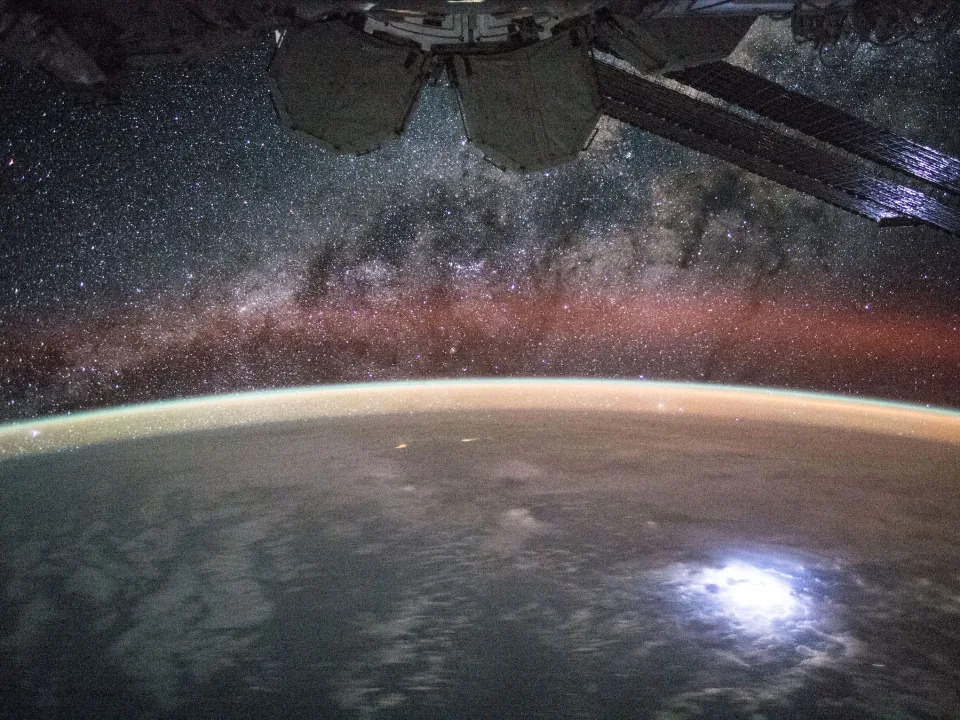
A time-lapse of the Milky Way Galaxy as seen from the International Space Station.NASA/Kjell Lindgren
UFOs (or UAPs) probably aren't aliens, NASA says. Rumors of "non-human" "biologics" are unconfirmed.
Extraterrestrial life likely wouldn't show up as flying objects, but finding it could cause similar chaos.
NASA's greatest challenge could be explaining any alien discovery to the public, the agency's planetary-science chief said.
NASA isn't announcing the existence of extraterrestrial life. But if this year's UFO mania shows anything, it's if the agency ever breaks such news, the world may have trouble understanding.
The trouble with talking about aliens and UFOs resurfaced on Thursday, when NASA released its independent report on "unidentified anomalous phenomena," or UAP. (That's the government term for the mysteries most people call UFOs.)
"If you ask me: Do I believe there's life in a universe that is so vast that it's hard for me to comprehend how big it is? My personal answer is yes," NASA Administrator Bill Nelson said in a press briefing on the report.
However, the study team concluded that there is no evidence UAP have extraterrestrial origins.
"It would have to be a very advanced civilization," Nelson said. "The distance is light years, hundreds of light years, billions of light years."
But in the briefing, NASA officials still had to deflect questions about a self-described "ufologist" who presented what he said were 1,000-year-old alien corpses to Mexico's Congress, and about ex-intelligence officer David Grusch's testimony that the government recovered "non-human" "biologics" from a crashed vehicle.

The object a self-described ufologist presented as the remains of a 'non-human' being, during a briefing on UFOs at the San Lazaro legislative palace, in Mexico City, Mexico.Henry Romero/Reuters
Those weren't even the most notable moments of UFO mania this year. Remember the "Chinese spy balloon" that the Pentagon shot down in February?

The suspected Chinese spy balloon drifts to the ocean after being shot down off the coast in Surfside Beach, South Carolina.Randall Hill/Reuters
Suddenly the US seemed to be spotting mysterious flying "objects" everywhere, and US fighter jets gunned down three more in the skies over Alaska, Canada, and Lake Huron. Even Elon Musk weighed in with an alien joke.
Maybe that's why NASA's UAP study team faced "nasty and hostile" online harassment, in the words of David Spergel, president of the Simons Foundation and chair of the team.
"Not only were some of the things that our panel members received, during the course of this study, simple trolling. Some of them actually rose to actual threats," Dan Evans, assistant deputy associate administrator for research at NASA's Science Mission Directorate, added in the briefing.

A woman looks at a UFO display outside of the Little A'Le'Inn, in Rachel, Nevada.AP Photo/John Locher, File
The harassment was so bad, officials said, that they're declining to share the name of NASA's new top UAP official.
The breathless rumors and hostile messages are just a peek at what Lori Glaze, who leads NASA's planetary science division, might face should scientists ever discover true evidence of life beyond Earth.

An apparently unidentified object detected on a Navy plane’s infrared camera.US Department of Defense/Navy Times
"You can't overstate just how important that discovery would be. How we're going to confirm that and announce it responsibly, I think is a really, really important question," Glaze told Insider at the American Geophysical Union's meeting in December.
"The biggest challenge is trying to keep that communication on an even keel, right? With an excitement, and yet also understanding that we need to set the expectations that we have to follow the scientific process."
How NASA scientists might explain any alien findings — gradually
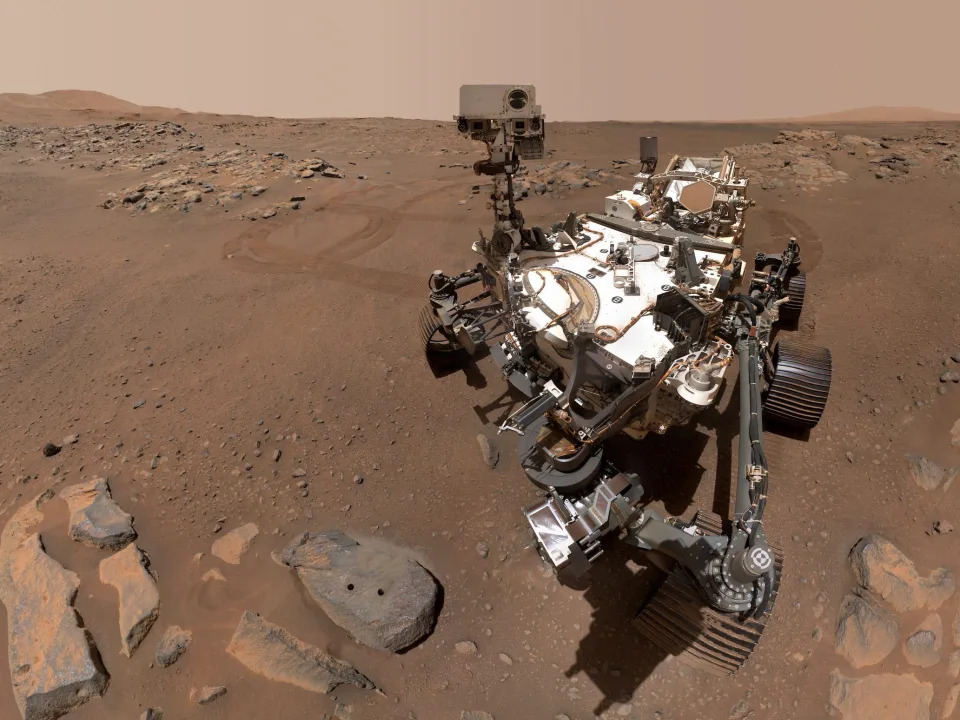
NASA's Perseverance rover took this selfie on Mars.NASA/JPL-Caltech/MSSS
Maybe the James Webb Space Telescope detects a telltale molecule in the atmosphere of a distant Earth-like planet. Maybe Mars samples from the Perseverance rover reach Earth in a decade, and scientists find fossils of ancient microbes inside them.
Many astrobiologists (exactly what it sounds like — people who study the idea of biology beyond Earth) think that evidence of extraterrestrial life could turn up soon.
But it's unlikely that any evidence would be completely, irrefutably, obviously aliens. Scientists will probably disagree, and won't be 100% confident. That could be hard to explain to the public.

Two people dressed as extra-terrestrials with aluminum foil costumes walk in the streets near the Peak of Bugarach, in France.Jean-Philippe Arles/Reuters
"This is going to be a very, very hard thing to actually get the scientific community, I think, to agree upon — unless we actually see something moving around and waving at us, which is unlikely," Glaze told Insider.
That's why NASA has tried to develop a procedure for assessing and sharing such a monumental, sensitive discovery. The conversation is still ongoing, Glaze said, but in 2021, the agency published a framework as a starting point. It could help scientists, journalists, and NASA itself explain the science.
It's called the "confidence of life detection" (CoLD) scale, rating scientific confidence in any potential alien-life discovery on a scale of one to seven. A possible detection can climb to higher levels of confidence as evidence builds.

An illustration of the CoLD scale for determining confidence in a detection of alien life.NASA/Aaron Gronstal
For example, a level one detection might be the discovery of a molecule that could be related to life inside a Perseverance Mars sample. The evidence would graduate to level two once scientists confirm there was no contamination in the sample, or the instruments involved, that could have influenced their findings. By ruling out non-biological sources of the molecule, or by confirming that it came from an environment suitable for life, scientists could move it further up the scale.
Other scientific teams would have to measure the Mars sample themselves, with different methods, and confirm the initial finding to graduate to level six.
According to NASA, in this Mars molecule example, additional evidence from a different part of the red planet may be necessary to bring it up to level seven — where it's probably life.
Each new level of confidence could mean a new public announcement.
The discovery of extraterrestrial life is likely to be a slow build-up, rather than an explosive eureka moment.
"Until now, we have set the public up to think there are only two options: it's life or it's not life," Mary Voytek, head of NASA's Astrobiology Program, said in a press release when the new scale was published. "We need a better way to share the excitement of our discoveries, and demonstrate how each discovery builds on the next, so that we can bring the public and other scientists along on the journey."
The president or other countries could be involved in announcing extraterrestrial life exists

President Joe Biden speaks at Delaware State University.Anna Moneymaker/Getty Images
Announcing the existence of alien life would be an "administration-level" affair, Glaze said, referring to the US presidency. It wouldn't just be NASA explaining itself at press conferences.
NASA might not even be the first entity to discover evidence of life on another planet. Another nation's space agency could find it first.
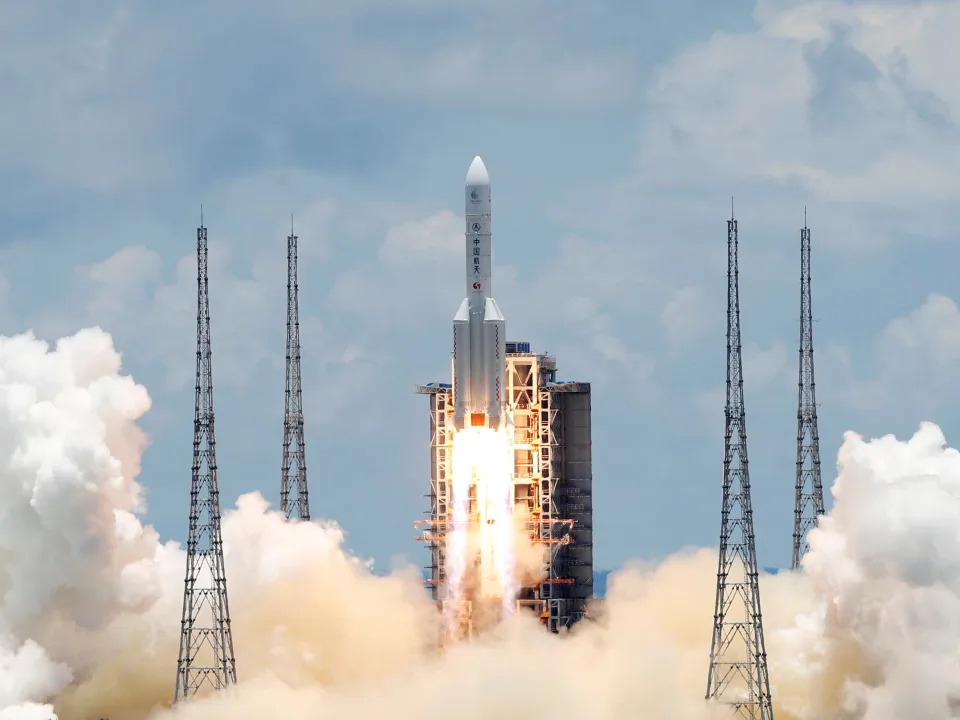
A Chinese Long March 5 Y-4 rocket lifts off, carrying a mission to Mars.Carlos Garcia Rawlins/Reuters
The discovery of intelligent alien life would be even more Earth-shattering. That would come with its own conundrums: How do we communicate with them? What do we say? And how might they respond?
Even beaming little hints of ourselves into the void has been controversial. In 1974, astronomers sent out radio signals containing the numbers one through 10, information about the composition and structure of DNA, a figure of a human and our global population, and a graphic of the solar system with Earth highlighted.
Critics like Stephen Hawking have said that contacting any extraterrestrial intelligence could pose an existential risk for humanity.
Needless to say, any discovery of alien life would likely lead to chaos — at least in public discourse.
Glaze said NASA's goal is to be a trusted, transparent source of clear scientific information. It could be the agency's biggest challenge yet.
"I'm not sure we even have words to describe it," she said. "The confirmation that we're not alone in the universe is, I think, going to be akin to realizing that the universe doesn't rotate around Earth. It's a very different way of thinking about who we are, where we came from."
This post has been updated to include new events. It was originally published on February 18, 2023.
BuzzFeed
Wed, September 13, 2023
Two "non-human" bodies were presented to Mexico's congress the other day when Mexico held hearings about UFOs just like the US did a couple months ago.
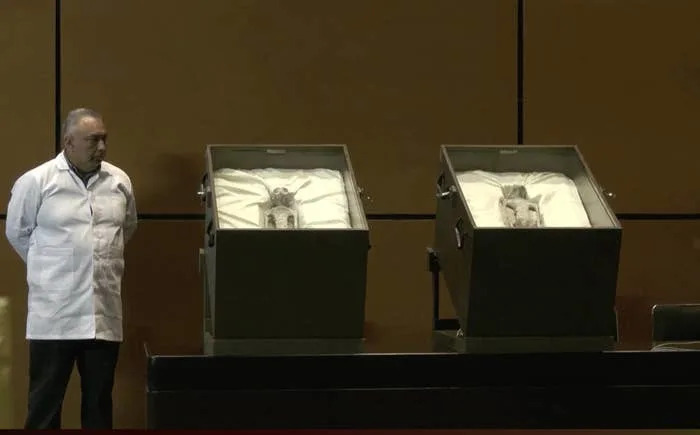
Reuters
The little critters were supposedly found in Peru in 2017.

Reuters
One of 'em is said to be 700 years old and the other is said to be 1800 years old.
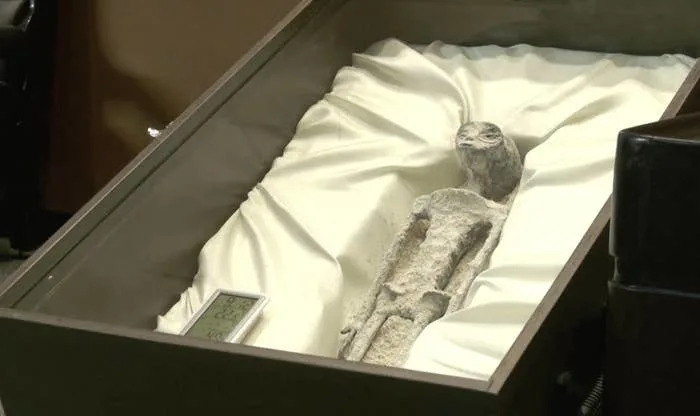
Reuters
According to CBS News, the "aliens" have only three fingers and elongated heads.

Reuters
A video from Al Jazeera is going super viral because of the reactions.
Reuters/Twitter: @AJEnglish
From "They purchased it at Spirit Halloween"...
Reuters/Twitter: @alt_bimbo_
... to "That's the Sour Patch Kid that fell under my bed a year ago."
Reuters/ Twitter: @GalaxyPeaBrain
The whole thing is pretty absurd.
Here are some of the funniest reactions:
Reuters/Twitter: @RobertScammell
Reuters/Twitter: @cvltistkid
Reuters/Twitter: @_MissZita
Reuters/Twitter: @jessolpunkass
Reuters/Twitter: @MichelleHigh
Reuters/Twitter: @boocahballz
Reuters/Twitter: @KMJeezy
Reuters/Twitter: @ChuckNowlinWZLX
Reuters/Twitter: @NYSocialBee
Reuters/Twitter: @caseyaonso
Reuters/Twitter: @jagerbott
me after a thc gummy https://t.co/ERx5aPBeP7 pic.twitter.com/FnYElKgFzu
— 🧚♂️ (@_ur_g4y) September 13, 2023
Reuters/Twitter: @_ur_g4y
And lastly...
Reuters/Twitter: @kenklippenstein


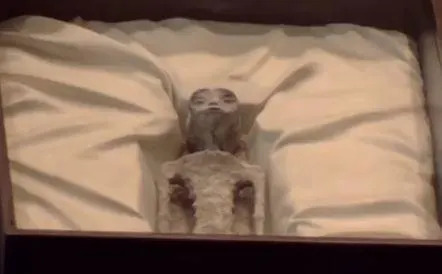

No comments:
Post a Comment